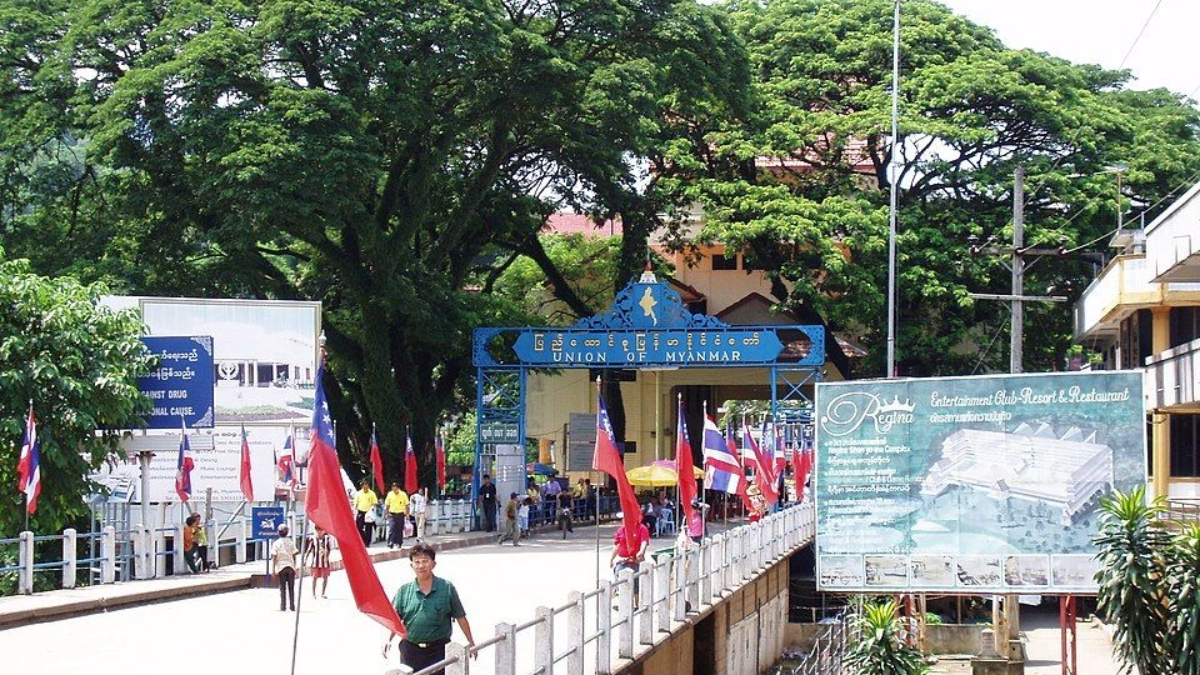How Technology and Regulatory Gaps Fuel Scam Compounds
Laura Scherling / Jul 18, 2025
The Myanmar-Thailand bridge in Mae Sai, Chiang Rai, Thailand. (Wikimedia Commons)
The fight against human trafficking and forced labor in Southeast Asia has seen significant setbacks in recent months — another seeming casualty of the United States foreign aid freeze. This includes the fight against scam compounds, a location typically operated by organized criminal gangs, where fraudulent operations occur at scale. Victims, some who were imprisoned in the region’s notorious scam compounds, have lost access to a shelter run by the Catholic charity Caritas. Global Alms, an NGO that combats human trafficking along the Thailand-Myanmar border, has reported losing their US State Department lifeline, which made up 60% of its funding. Jalil Muyeke, a survivor of a scam compound warned the actions would backfire on the US: “They are digging a grave for themselves … it’s Americans who are the predominant targets.”
Muyeke, like many victims of the ongoing “scamdemic,” the ongoing increase in online frauds and scams, was led to believe he was starting a new data entry position in Bangkok. Upon arrival in Thailand from his home in Uganda, he was kidnapped and shuttled across the border to Myanmar where he was held for months. While imprisoned, Muyeke was forced to pose as a woman online and had a quota to acquire phone numbers of two men a day. Muyuke managed to convince his captors to free him, which is not always a possibility for trafficked victims. The United Nations has noted that often scam center workers are not released unless a ransom is paid by their families and those who attempt to escape might be tortured or killed.
Horrifying stories like Muyeke’s have become more familiar. In January, the case of a Chinese actor abducted into a scam compound went viral. A report last year by the UN Office on Drugs and Crime found that cyber-enabled fraud has intensified, resulting in billions of dollars in losses, with many of these crimes led by groups in Southeast Asia. The UN has estimated that hundreds of thousands of people are being trafficked and forced to work in a combination of scam centers and online operations.
Cyber crime accounts for just one part of the scourge of human trafficking. While the penalties for drug trafficking are huge, the trafficking of human beings persists as a largely invisible crisis. Human trafficking takes on many forms: exploitation in sex and entertainment, agriculture, hospitality, and in cyber scams. Cyber-enabled human trafficking, trafficking leveraging the internet and other modern technologies, represents a relatively new, destructive, force amplifier. Benedikt Hofmann, the UNODC Deputy Regional Representative for Southeast Asia and the Pacific, has called Southeast Asia the “the ground zero for the global scamming industry.”
Cyber crime syndicates are rapidly evolving their use of technologies to include artificial intelligence, deepfakes, malware, and cryptocurrencies for laundering money. Armed with new AI-powered tools, malicious actors can create sophisticated chatbots and voice clones. AI is not only used to lure victims into financial scams like pig butchering, a type of long con leveraging trust and emotional connections typically built via online messaging platforms, but can also be used in the recruitment of victims of trafficking for forced criminality.
The pandemic created the perfect storm for a surge in scam compounds. The victim profile became more global with people looking for jobs and willing to travel. The International Organization for Migration (IOM) in Thailand, a UN-related organization, noted in an interview that I conducted for this article that victims of trafficking for forced criminality have been predominantly men between 20 and 35, educated at different levels, and are “frequently targeted” for being multilingual. They are legitimately skilled in tech work and, so far, the IOM have “identified victims from more than 45 different nationalities.” Meanwhile, the shells of casinos and buildings that were hastily abandoned could be exploited and in some instances rebuilt into scam centers. Criminal groups soon realized that scamming operations were highly lucrative.
As law enforcement have become attuned to the scam compounds, crime syndicates have become more mobile and can relocate a compound after completing a “life cycle of operations.” Once limited to border areas, scam centers have fanned out across Southeast Asia. In the Philippines, observers say scam compound operators are fragmenting into smaller units in order to help obscure their visibility. A combination of people and tech infrastructure that enable scam operations are particularly alarming. This has been closely studied by Global Initiative Against Transnational Organized Crime (GI-TOC). Criminal groups hail from different parts of Asia. Yakuza-affiliates, Chinese-speaking criminal networks, and the Myanmar ethnic armed organization United Wa State Army, are among the criminal actors involved in scam operations. Bad actors also include people on the outside. Recruiters who post fake jobs and traffic victims to compounds are scattered geographically. Corrupt officials have been known to support scam operations. According to GI-TOC, IT personnel provide critical crime-as-a-service provisions to compounds like “IT support, websites and apps used in scams (for instance, fake versions of legitimate investment platforms).”
Scam compounds use a whole host of tech platforms. The IOM in Thailand has observed ongoing regulatory gaps on the use of “enabling” technologies, including mainstream platforms like Facebook, Messenger and WhatsApp. The mainstream use of tools extends to mirror websites and marketing materials, AI, and Starlink devices. IOM noted that the use of commercial tools “to maintain operations in remote areas with limited surveillance” makes “enforcement and victim identification even more challenging.” This suggests an important regulatory gap around these commercial tech tools which frequently target Americans and may even be made in America. Criminal actors may be located anywhere, and subject to limited effective regulation. Efforts by major tech companies may be too limited in context of the “booming illicit economy” of transnational criminal groups in Southeast Asia.
In 2024, Meta announced their plans to counter scam compounds by collaborating with industry partners and law enforcement, banning criminal entities through their “Dangerous Organizations and Individuals Policy,” and scaling up automated detection. In 2024, Meta estimated they took down “two million accounts associated with scam centers in Cambodia, Myanmar, Laos, the United Arab Emirates and the Philippines.” But, Meta’s 2025 rollback of its US fact checking program, its reduction in force across some of its content moderation contractors, as well as recent reports that “Meta has deprioritized scam enforcement in recent years” amidst an “epidemic of scams” leaves questions. Meanwhile, multiple reports have surfaced citing the use of Starlink by scam compounds. Along the Myanmar-Thailand border at least eight scam compounds were detected using Starlink devices.
Still, so much is needed to support and repatriate scam compound victims. “A human rights-based and trauma-informed response is required that places victims and their needs at the centre,” IOM relayed. IOM cites a multifaceted response that calls for enhanced capacity of frontline officers and better understanding of the “profile of victims, regional flows, and trends.” IOM also advocates for “non-punishment principles to avoid detention for individuals who are identified as victims of trafficking,” and direct assistance like food, shelter, and psychosocial support. Partnerships are crucial to counter trafficking efforts. More coordinated efforts means fostering “policy dialogue platforms” between “source, transit and destination countries.” But with limited support by partners in Thailand and “the instability in Myanmar,” IOM repatriation operations and the implementation of a “functional transnational referral mechanism” is hindered. They noted, “Victims who manage to escape and are rescued often lack legal documentation, exposing them to the risk of arrest, detention, or deportation- further complicating protection and repatriation efforts.”
Despite growing attention to scam compounds, counter trafficking efforts in Southeast Asia have been slowed down by advanced use of technologies by criminal entities, and reduced foreign aid. The retrenchment of federal funding leaves Americans and people everywhere at greater risk, and potentially accelerates the trafficking of people.
Authors
